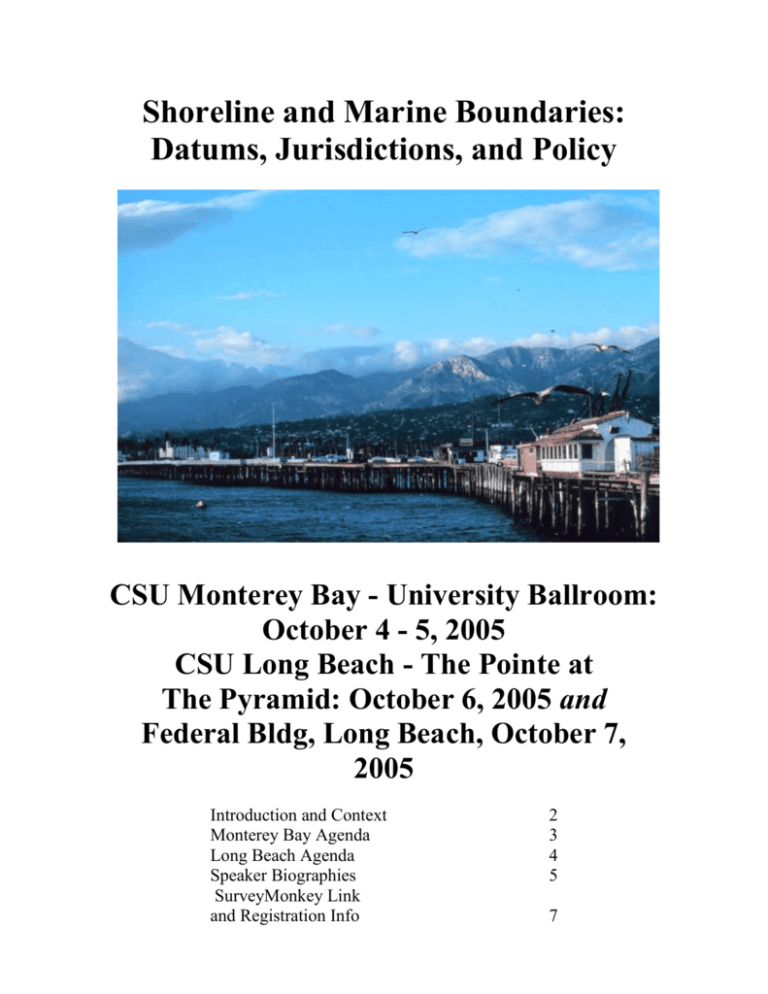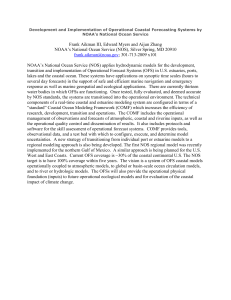Greetings - California State University, Long Beach
advertisement

Shoreline and Marine Boundaries: Datums, Jurisdictions, and Policy CSU Monterey Bay - University Ballroom: October 4 - 5, 2005 CSU Long Beach - The Pointe at The Pyramid: October 6, 2005 and Federal Bldg, Long Beach, October 7, 2005 Introduction and Context Monterey Bay Agenda Long Beach Agenda Speaker Biographies SurveyMonkey Link and Registration Info 2 3 4 5 7 Greetings! A workshop has been organized to offer you the opportunity to learn and exchange information about tidal datums, geodetic vertical datums, how they relate, how they impact shoreline and offshore boundaries, and policy implications thereof, such as Marine Protected Area determinations and effectiveness. Developed by Marti Ikehara, National Ocean Service, NOAA and Paul Veisze, California Department of Fish and Game, Resources Agency, both of Sacramento, CA, the event is 1.5 days in two locations in California: CSU Monterey Bay on October 4 and 5, 2005 and CSU Long Beach on October 5 and (elsewhere in LB on the) 6, 2005. Entitled “SHORELINE and MARINE BOUNDARIES: DATUMS, JURISDICTIONS, and POLICY”, the purpose of this workshop is to bring subject matter experts together from national programs and from the California community for mutual education and discourse on technical practices and applications. CONTEXT Tidal datums are the basis for establishing "the" shoreline and international, federal, and state sovereign lands and waters, as well as controlling the location and extent of habitat for tidally-sensitive marine flora and fauna. However, the built environment (development) and floodzone determinations, for example, are based on other vertical datum(s). Because tidal datums are relevant (accurate) to only a local area at the shore, determining elevations related to a uniform, widespread, unshifting, geodetic vertical datum, such as North American Vertical Datum of 1988 (NAVD88), allows vertical data for projects to have a common frame of reference at a regional, or even national, scale. The target audience is the geospatial professional concerned with elevation data, land/water boundaries and jurisdictions, and associated policies. The first day of the workshop will consist of presentations and two panel discussions. Your input will determine what 3 topics will be discussed, each for an hour in an open format, on the second day. The vision for the second day has been to provide an opportunity for colleagues to discuss issues of concern or interest to themselves. The round-table format is conducive to sharing success stories, problems seeking solutions, and/or feedback to public agencies with legal or jurisdictional responsibilities. 2 Shoreline and Marine Boundaries: Datums, Jurisdictions, and Policy CSU Monterey Bay - University Ballroom: October 4 - 5, 2005 AGENDA *confirmation pending Context - Theory –- Measurements (Moderator: Paul Veisze, DFG) 08:30 Oct 4: Welcome *California Central Coast Joint Data Committee (CCJDC) 08:35 Objectives & Introductions Marti Ikehara, NOS/NGS 08:45 Basics of Tidal Datums Jim Hubbard, Jerry Hovis, NOS/CO-OPS 09:45 Geodetic Vertical Datums, NAVD88 and NGVD29 Ikehara, NOS/NGS 10:15 Break 10:30 VDATUM: Integrating Tidal and Vertical Datums Jason Woolard, NOS/NGS 11:00 California Segment of National Baseline Woolard, NOS/NGS 11:30 Case study, Part 1: Elkhorn Slough Wetland Elevations Eric Van Dyke, ES NERR 12:00 Lunch (no-host box w/drink ~$20) Applications--Management – Policy *Moderator 13:00 Case study, Part 2: Elkhorn Sl. Ecosystem Management Eric Van Dyke, ES NERR 13:30 Synthesis & Local Perspectives David Revell, UCSC 14:00 Marine Boundaries—Best Practices Dave Stein, NOAA/CSC 14:15 Break 14:30 Panel: National Perspectives Woolard, NOS/NGS; Cindy Fowler, NOS/CSC Herrick (Rick) Hanks, DOI/BLM Lee Thormahlen, DOI/MMS; *USACE 15:30 Panel: State and Regional Perspectives Mike Bell, SLC; John Ugoretz, DFG Greg Benoit, CCC; *SCC Brian Fulfrost, CJDC 16:30 California Priorities – Open discussion 17:00 Adjourn -08:30 - 12:30 Oct 5: Focused Discussions (based on attendee voting) Locally sponsored by the Central Coast Joint Data Committee and the Association of Monterey Bay Area Governments 3 All All Shoreline and Marine Boundaries: Datums, Jurisdictions, and Policy The Pointe at The Pyramid, CSU Long Beach: October 6, 2005 and Federal Bldg, Long Beach: October 7, 2005 AGENDA *confirmation pending Context - Theory – Measurement (Moderator: Marti Ikehara, NOS/NGS) 08:30 Oct 6: Welcome *CSULB Pres or Suzanne Wecshler 08:35 Objectives & Introductions Paul Veisze, CA DFG 08:45 Basics of Tidal Datums Jim Hubbard, Jerry Hovis, NOS/CO-OPS 09:45 Geodetic Vertical Datums, NAVD88 and NGVD29 Ikehara, NOS/NGS 10:15 Break 10:30 VDATUM: Integrating Tidal and Vertical Datums Jason Woolard, NOS/NGS 11:00 To be determined 11:30 California Segment of National Baseline Meredith Westington, NOS/CS 12:00 Lunch (no-host box w/drink ~$20) Applications -- Management – Policy (Moderator: Becky Smyth, NOS/CSC) 12:45 Case study: Relationships between Tidal Height and Species Abundances: Implications for Monitoring Rocky Shores Steven Murray, CSUF 13:30 Synthesis & Local Perspectives Fred Henstridge, Psomas 14:00 Marine Boundaries—Best Practices Dave Stein, NOAA/CSC 14:15 Break 14:30 Panel: National Perspectives Herrick (Rick) Hanks, DOI/BLM Westington, NOAA/CS; Lee Thormahlen, DOI/MMS Cindy Fowler, NOAA/CSC ; *USACE 15:30 Panel: State and Regional Perspectives Mike Bell, SLC; Chris Lowe, CSULB Jonathan van Coops, CCC *DFG; *SCC 16:30 California Priorities – Open discussion 17:00 Adjourn -08:30 - 12:30 Oct 7: Focused Discussions (based on attendee voting) 4 All All Shoreline and Marine Boundaries: Datums, Jurisdictions, and Policy CSU Monterey Bay (4,5Oct05) – CSU Long Beach (6,7Oct05) Snapshot Biographies for Speakers, Day 1 Michael Bell, Senior Boundary Determination Officer. California State Lands Commission, Sacramento, CA. Land surveying, land title, water boundaries Greg Benoit, Assistant GIS Program Manager. California Coastal Commission; Santa Cruz, CA. Coastal land use and resource mapping, image analysis, cartographic design and publication Cindy Fowler, GIS Program Manager, NOAA, Coastal Services Center; Charleston, SC. GIS integration and development in NOAA, co-chair of the FGDC Marine Boundaries Working Group, development of coastal and marine NSDI within Federal agencies Brian Fulfrost, Lecturer, GIS Coordinator, University of California Santa Cruz; Santa Cruz, CA. Spatial analysis, environmental science and decision making, policy studies Herrick (Rick) Hanks, Manager, California Coastal National Monument, DOI Bureau of Land Management; Monterey, CA. Natural & cultural resources manager (and keeper of the more than 20,000 off-shore rocks & small islands of the CCNM) Jim Hubbard, Oceanographer, NOAA, National Ocean Service, Center for Operational Oceanographic Products and Services; Silver Spring, MD. Tidal datum determinations from observations, advises other agencies about water level (tide) gages, tidal wetland restoration, marine boundary disputes Fred Henstridge, LS, Vice President, Corporate Director of Geospatial Services and GIS, Psomas; Costa Mesa, CA. Land surveying, transportation engineering, project management Marti Ikehara, California State Geodetic Advisor, NOAA, National Ocean Service, National Geodetic Survey; Sacramento, CA. Geodetic control, tidal and vertical datums, land subsidence, NAVD88 propagation Dr. Chris Lowe, Associate Professor, Marine Biology, Director of Shark Lab, California State University Long Beach; Long Beach, CA. Elasmobranch research, movement patterns and site fidelity of game fishes in MPAs, catch and release policy effectiveness, movement patterns of sharks and ulua Dr. Steven Murray, Professor of Marine Biology, Dean of School of Sciences, California State University Fullerton; Fullerton, CA. Marine intertidal ecology, influence of intertidal elevations on marine population distribution, MPA determinations, MPA effectiveness David Revell, Doctoral Candidate, University of California Santa Cruz; Santa Cruz, CA. Coastal geoscientific research Rebecca Smyth, California Regional Coordinator, NOAA, National Ocean Service, Coastal Services Center, San Francisco, CA. Coordinating California NOAA and partner 5 efforts in ocean observing monitoring programs, Project Manager for Southern CA Coastal Storms Program, Coastal Zone Management issues Dave Stein, Spatial Data Analyst and Project Manager, NOAA, Coastal Services Center; Charleston, SC. Digital marine boundary and shoreline development, Federal geospatial policy and initiatives, GIS integration and development Lee Thormahlen, Chief, Mapping and Boundary Branch, DOI Minerals Management Service; Denver, CO. Submerged Lands Act boundaries, coordination with coastal states, marine boundaries, implementation of the Multipurpose Marine Cadastre John Ugoretz, Nearshore Ecosystem Coordinator/Central Marine Region Manager. California Department of Fish and Game; Monterey, CA. Marine Protected Area operations and policy, central coast program management Jonathan van Coops, Mapping/GIS Program Manager, California Coastal Commission; San Francisco, CA. Coastal land use and resource mapping, image analysis, cartographic design and publication Eric Van Dyke, Geographical Ecologist, Elkhorn Slough National Estuarine Research Reserve; Watsonville, CA. Marsh elevation monitoring, tidal erosion, historical ecology, coastal imagery Paul Veisze, GIS Research Manager, California Department of Fish and Game; Sacramento, CA. Marine science, spill prevention, watershed boundaries, geographic names Meredith Westington, Chief Geographer. NOAA, Coast Survey; Silver Spring, MD. National Baseline, law of the sea, maritime zones, nautical charts Jason Woolard, Cartographer. NOAA, National Ocean Service, National Geodetic Survey; Silver Spring, MD. VDATUM software, airborne topographic lidar, emerging technologies for coastal mapping 6 RESPONSES REQUESTED We are utilizing the capability of SurveyMonkey, a web-based questionnaire, to record your preferences for discussion topics for Day 2. Each topic will be discussed for an hour. Because this survey is free, only the first 100 responses for each location are allowed. The format of the survey is that you will be asked to answer which topic you most want to discuss, and in a different question, which topic you second most want to have on the agenda. Please review the choices here first, and if you probably or definitely will not attend Day 2, please do not fill out (or even start!) the questionnaire. The topics from which to choose are: Permitting/Restricting Development relative to Tidal Datums Law Enforcement based on Marine (offshore) Boundaries Legal Cases involving MPA Boundary Issues Effectiveness of MPA/Restrictive Zone Delineation Legal Cases involving Coastal Ownership or Jurisdictions Wetland Restoration Efforts wrt Elevation/Tidal Determinations The SurveyMonkey survey for Monterey Bay can be found here: http://www.surveymonkey.com/s.asp?u=350501268118 This questionnaire has a sea GREEN background. The survey will be open until August 31 or until 100 responses are received for that location’s survey, whichever is first. The SurveyMonkey survey for Long Beach can be found here: http://www.surveymonkey.com/s.asp?u=802991278575 This questionnaire has a sea BLUE background. REGISTRATION We want to first collate the responses and choose the topics for Day 2 before starting the registration process. We expect to open registration on September 6, at which time you would indicate your attendance on Day 1 and/or Day 2, and lunch choice. Registration will be first come, first served with a possible limit for Day 2 in Long Beach. Registration will end no later than September 25, 2005. There will be NO CHARGE for the workshop but you will be asked to pay for your box lunch and break refreshments when you check in. An email announcement will be made on September 1 indicating the selected topics from the survey results and the registration process. To ensure that you receive this notice, send an email request: Monterey Bay: pveisze@dfg.ca.gov Long Beach: marti.ikehara@noaa.gov 7








